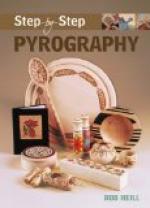The Sussex youth used all his powers of language, which were limited, and all his strength of will, which was great, in trying to induce Audrey to leave service and go home to her people. Audrey was quiet, but she was as set as Blackcap Down.
“’Tis not my own fancy, Dickon,” she pleaded at last, her blue eyes dim with tears. “I ha’ no love for strange lands,—nor strange folk neither. But my lady has been ever kind to me, and she is in great trouble. If she fall ill on the journey there is none but me that knows her ways. I should ha’ no peace if I left her in strange hands. ’Tis my duty, Dickon. There’s no two ways of duty for any christened soul.”
Dickon grew bolder at the sight of those tears. “Audrey,” he said, “when you come back, and your lady is among her own folk again—then will you break the silver penny with me?”
“Oh,” said Audrey shyly and quickly, her eyes downcast, “I’ll do that now, if ye like,—Dickon, lad.”
So they broke the coin and each kept half, and said farewell, she for the sake of her duty and he for the sake of his own honor, which was bound up with hers. But after she had gone away he was troubled by many doubts whether he should not have held on, and made her come with him in spite of herself.
Meanwhile he had no mind to return to England, and found work where he was. The little shop of Gaston of Abbeville would have interested any lad in love with the armorer’s trade, and it had more attraction for Dickon than anything else he had found in that place. Wedged in, like a nutshell in the jaws of a nutcracker, between a round tower built by Rollo’s men and the far older wall of a Roman basilica, it was partly built of Norman stone-work and partly of oak. Set close to the old Roman road through Gaul, it was in view of any knight or squire or man-at-arms who went by, and it was so arranged that all the contents could be seen at a glance.
The heavy and bulky forge and tools of an English smithy were not to be seen. Since horses were not shod there, little room was needed, and the armorer could lay his hand on any tool he needed without taking more than a step or two. Hammer, tongs, bellows and other belongings not at the moment in use were hung tidily on the walls. Some of these were most skillfully shaped to their use, and also ornamented with carving on the handles. The carving was not only decorative but was so designed as to give a firmer hold to the hand.
Along the upper part of the rear wall and the end wall on the right, supported on corbels of stone, was a narrow gallery, built of oak, the front carved in a series of open interlacing arches. Inside this were suits of costly armor, and weapons of especial value, which the armorer kept for sale. A flight of steps closed in by a paneled oaken partition descended from this gallery to the ground, and on each step was the straight demure figure of a carved saint in a pointed arch like a shrine. At the foot the stairway




